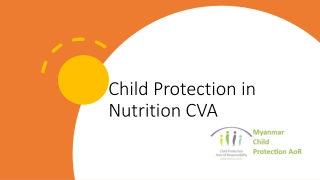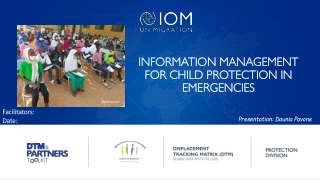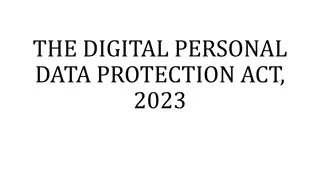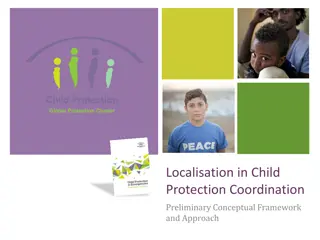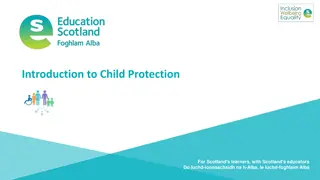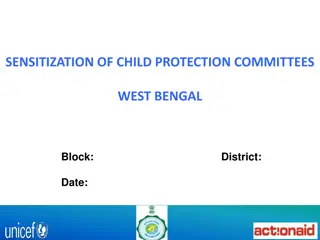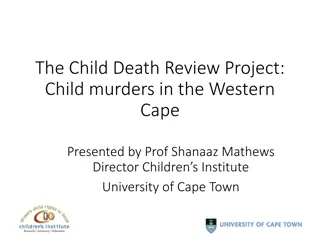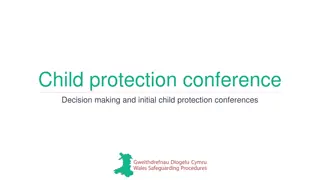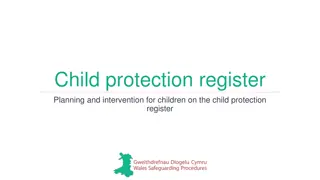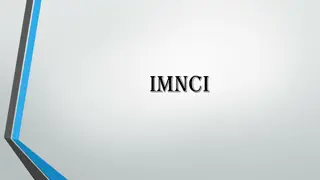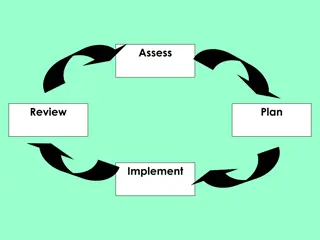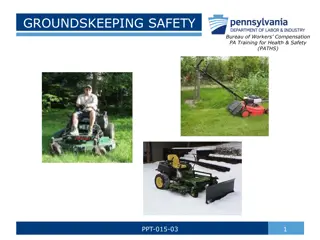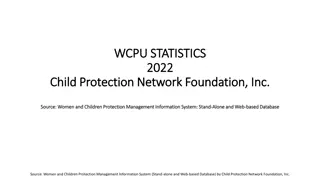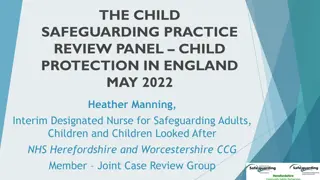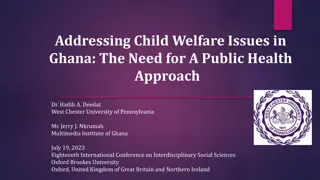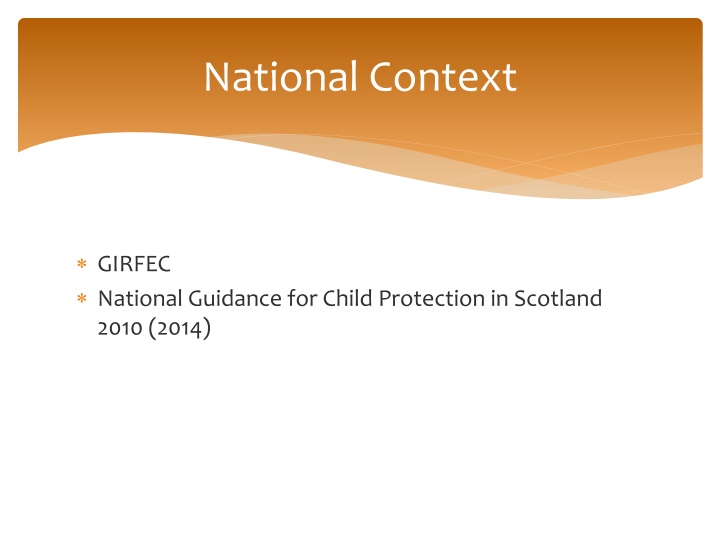
Child Protection and Wellbeing Guidelines in Scotland
Explore the National Context guidance for child protection in Scotland, emphasizing the importance of enhancing skills, ensuring digital safety, and responding effectively to child protection issues. Learn about the GIRFEC approach, Daniel Pelka case, and the role of Named Persons in coordinating support for families and children. Understand the key questions to address for promoting children's wellbeing and safety.
Download Presentation

Please find below an Image/Link to download the presentation.
The content on the website is provided AS IS for your information and personal use only. It may not be sold, licensed, or shared on other websites without obtaining consent from the author. If you encounter any issues during the download, it is possible that the publisher has removed the file from their server.
You are allowed to download the files provided on this website for personal or commercial use, subject to the condition that they are used lawfully. All files are the property of their respective owners.
The content on the website is provided AS IS for your information and personal use only. It may not be sold, licensed, or shared on other websites without obtaining consent from the author.
E N D
Presentation Transcript
National Context GIRFEC National Guidance for Child Protection in Scotland 2010 (2014)
Learning Outcomes Knowledge of the current context for Child Protection Enhance skills to screen information, apply thresholds & take appropriate action Awareness of Digital Safety issues Ensure appropriate response to allegations against staff
Getting It Right For Every Child Everyone has a responsibility to do the right thing for each child and we must all work towards a unified approach, with less bureaucracy and more freedom to get on and respond to children. This will mean earlier help and the child getting the right help at the right time packaged for their particular needs.
Daniel Pelka, Died 3rd March 2012 A pattern of domestic abuse from November 2006 changed little, despite interventions by police and social care professionals. The SCR report says that at times Daniel appeared to have been invisible against the backdrop of his mother s controlling behaviour and that professionals needed to think the unthinkable and act on what they saw in front of them rather than accept parental versions of what was happening. Coventry LSCB Final Overview Report of Serious Case Review re Daniel Pelka - September 2013
GIRFEC Named Person Birth school starting age, Health visitor (or other suitable health professional) School age Headteacher (or promoted teacher)
Named Person Point of contact for the family and professionals Co-ordinates support from within their own agency or service Ensures the participation and inclusion of children/young people and their parents/carers Undertakes the Shared Assessment (if required) Calls a Child s/Young Person s Planning meeting (if required) Communicates with the Lead Professional (where appointed)
The GIRFEC Questions 1. What is getting in the way of this young person s wellbeing? 2. Do I have all the information I need to help this young person? 3. What can I do now to help this young person? 4. What can my agency do to help? 5. What additional help, if any, may be needed from others? 6. What is the child/young person, parent or carer saying about the situation?
There are three main tools to help professionals answer the six key questions. These are: The wellbeing indicators Central to understanding how children grow and develop. The My World Triangle - a common, evidenced based, holistic framework to help professionals understand the child s whole world. The Resilience Matrix - a framework for weighing up particular risk factors against protective factors for the individual child
Well-being Indicators Safe Healthy Achieving Nurtured Active Respected Responsible Included
Child Protection 37. 'Child protection' means protecting a child from child abuse or neglect. Abuse or neglect need not have taken place; it is sufficient for a risk assessment to have identified a likelihood or risk of significant harm from abuse or neglect. National Guidance for Child Protection in Scotland, 2014
Risk is something that increases the chance of a specified (negative) outcome whether single or accumulative Protective factors are circumstances that moderate the effects of risk in a positive direction whether single or accumulative Vulnerability can be determined by a point of time such as age and development stage.
Information Sharing It is important to note that the Supreme Court judgment itself does not require current policy to change. The judgement relates only to the information sharing provisions that were intended to come into force under the Act, not to current practice under GIRFEC policy.
National Guidance for Child Protection in Scotland 2010 (2014) Procedures and guidance cannot in themselves protect children; a competent, skilled and confident workforce, together with a vigilant public, can
Role of Education 182. Education practitioners, school staff and staff in other learning settings play a crucial role in the support and protection of children as well as the development of their wellbeing. National Guidance for Child Protection in Scotland, 2014
Child Protection in Specific Circumstances Indicators of Increased Risk of Significant Harm (1) Domestic abuse Parental alcohol and drug misuse Disability Non-engaging families Children and young people experiencing or affected by mental health problems
Child Protection in Specific Circumstances Indicators of Increased Risk of Significant Harm (2) Children and young people who display harmful or problematic sexual behaviour Female genital mutilation Honour-based violence and forced marriage Fabricated or induced illness Sudden unexpected death in infants and children National Guidance for Child Protection in Scotland, 2014
Significant Harm 42 events that interrupt, change or damage the child's physical and psychological development. National Guidance for Child Protection in Scotland, 2014
Significant Harm 40. Significant harm can result from a specific incident, a series of incidents or an accumulation of concerns over a period of time. It is essential that when considering the presence or likelihood of significant harm that the impact (or potential impact) on the child takes priority and not simply the alleged abusive behaviour. National Guidance for Child Protection in Scotland, 2014
Female genital mutilation This refers to all procedures which involve the partial or total removal of the external genitalia or other injury to the female genital organs for non-medical reasons World Health Organisation
Female genital mutilation Female Genital Mutilation is known by different names including cutting , female circumcision , and initiation . It is also sometimes referred to as sunna , although FGM predates Christianity and Islam and is not approved by any religion. fgmaware.org
Child Abuse In your groups, write a definition for the different types of abuse
Types of Abuse Physical Abuse Sexual Abuse Emotional Abuse Neglect
Physical Abuse Physical abuse is the causing of physical harm to a child or young person. Physical abuse may involve hitting, shaking, throwing, poisoning, burning or scalding, drowning or suffocating. Physical harm may also be caused when a parent or carer feigns the symptoms of, or deliberately causes, ill health to a child they are looking after.
Sexual Abuse Sexual abuse is any act that involves the child in any activity for the sexual gratification of another person, whether or not it is claimed that the child either consented or assented. Sexual abuse involves forcing or enticing a child to take part in sexual activities, whether or not the child is aware of what is happening. The activities may involve physical contact, including penetrative or non-penetrative acts. They may include non- contact activities, such as involving children in looking at, or in the production of indecent images or in watching sexual activities, using sexual language towards a child or encouraging children to behave in sexually inappropriate ways.
Emotional Abuse Emotional abuse is persistent emotional neglect or ill treatment that has severe and persistent adverse effects on a child's emotional development. It may involve conveying to a child that they are worthless or unloved, inadequate or valued only insofar as they meet the needs of another person. It may involve the imposition of age - or developmentally - inappropriate expectations on a child. It may involve causing children to feel frightened or in danger, or exploiting or corrupting children. Some level of emotional abuse is present in all types of ill treatment of a child; it can also occur independently of other forms of abuse.
Neglect Neglect is the persistent failure to meet a child's basic physical and/or psychological needs, likely to result in the serious impairment of the child's health or development. It may involve a parent or carer failing to provide adequate food, shelter and clothing, to protect a child from physical harm or danger, or to ensure access to appropriate medical care or treatment. It may also include neglect of, or failure to respond to, a child's basic emotional needs. Neglect may also result in the child being diagnosed as suffering from 'non-organic failure to thrive', where they have significantly failed to reach normal weight and growth or development milestones and where physical and genetic reasons have been medically eliminated.
Effects of neglect Type of effect Infants 0-2 Early Childhood The School Years Development poor growth/ intellectual capacity under stimulation nappy rash, infections, hospital attendances failure to thrive short stature, dirty, unkempt delay in learning new skills learning slow and painful language delay severe educational deficits: learning disabilities, poor problem solving poor reading, writing and maths Behaviour withdrawn, lethargic, depressed self stimulating behaviour e.g. rocking lacking social skills either aggressive or withdrawn indiscriminate friendliness disruptive/overactive in class desperate for attention few friends overcompensation Emotional no learned trust shame and self doubt lack of confidence and expectation of failure poor self concept encopresis/enuresis guilt/self blame self harming disturbed eating patterns (adapted from Skuse 1994) 28
Why is neglect so important? It is bad for children s learning lack of exploration delayed speech and language impoverished play and imagination special educational needs / learning disability later educational failure poor life skills. 29
Why is neglect so important? It is bad for children s brains lack of nutrients - reduced growth lack of stimulation delayed brain development unregulated stimulation - disordered neural circuitry. Increasingly an understanding that this can result in permanent reduced functioning which has a lifelong impact on the child s health and development 30
Why is neglect so important? It is bad for children s emotions disturbed self-regulation negative self identity low self esteem clinical depression substance abuse 31
Why is neglect so important? It is bad for children s relationships insecure/disorganised internal working model attachment disorders transmission of relationship problems to significant others, for example, peers, teachers, substitute carers, professionals. 32
Why is neglect so important? It is bad for our society long-term effects on adult physical and mental health and on individuals social and occupational adjustment; financial cost of treating or incarcerating victims; possible association between child neglect and future anti social and criminal behaviour; intergenerational transmission of neglectful parenting for future generations. 33
Impact of Neglect Children who experience rejection or neglect are more likely to develop antisocial traits as they grow up and are more associated with borderline personality disorders and violent behaviour (Schore, 2003).
Impact of Neglect Abused and neglected adolescents are estimated to be at least 25 per cent more likely to experience problems such as delinquency, teen pregnancy, low academic achievement, drug use, and mental health problems (Kelley et al 1997).
Domestic Abuse Domestic abuse is common. One in five women in Scotland experiences domestic abuse at some stage in her life according to the Scottish Crime Survey
Other Forms of Abuse/Indicators of Risk Domestic Abuse Parental alcohol and drug misuse Disability Non-engaging families Children and young people experiencing or affected by mental health problems Children and young people who display harmful or problematic sexual behaviour Female genital mutilation Honour-based violence and forced marriage Child trafficking Online and mobile phone child safety Children and young people who place themselves at risk Children and young people who are missing Under-age sexual activity Bullying
Impact of Domestic Abuse on Children Children in violent homes face three risks: the risk of observing traumatic events, the risk of being abused themselves, the risk of being neglected. (Mullender et al. 2003), quoted in Domestic Violence Child Protection and impact on Children, NSPCC Northern Ireland Paper
Impact of Domestic Abuse on Children Research consistently shows that children living with domestic abuse have higher rates of depression, trauma symptoms, and behavioural/cognitive problems than other children. (Humphreys 2006), quoted in Domestic Violence Child Protection and impact on Children, NSPCC Northern Ireland Paper
Impact of Domestic Abuse on Children In 90% of incidents, children are in the same or next room to the violence (Jaffe et al. 1990, McGee 200, Mullender et al. 2002). Evidence suggests that witnessing DV may be as harmful to children as suffering physical abuse (Margolin, 1998). Domestic Violence Child Protection and impact on Children, NSPCC Northern Ireland Paper
Your Role in Child Protection Anyone who knows or suspects that a child has suffered, is suffering, or is at risk of child abuse is required to make a Child Protection referral to Social Work or Police without delay.
Your Role It is not your role to investigate It is your role to listen to the child and record the concern Pass on your concerns Where appropriate, advise the family that you will be passing on your concern.
Points of Contact Children s Services Social Work childcare@clacks.gov.uk Education Helen Munro 01259 452441 NPService@clacks.gov.uk
Information required Details of the child and family Nature of concern Who, what, where, when Context Referrer s details
Use of open questions What happened? Did somebody hit you? X When did it happen? Did it happen last night? X Where did it happen? Did she come into your bedroom? Who did it? Was it mummy? X X
Recording of concerns Factual, consistent and accurate. In the child s own words. As soon as possible, certainly the same day. Recorded by the person noting the concern. Amendments/additions signed and dated. Records are legal documents.
What happens next An IRD [Initial Referral Discussion] will take place between representatives from Health, Police, Education and Social Work. Possible outcomes: No action Monitoring Child Welfare Child Protection Information fed back to referrer
Joint Investigative Interview Decided by IRD. May seek your advice on child s presentation/development. Consideration of who to accompany child. Parental consent not required. Police/Social work should advise family.
Child Protection Case Conference 21 days after initial referral Reports to be submitted in advance Chronology Shared with family in advance of meeting Assessment Review after three months Subsequent reviews every six months Core group to meet regularly
Stop Here Scenarios if time allows

